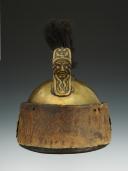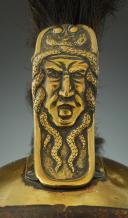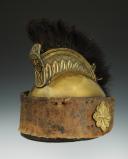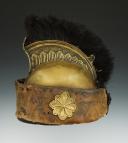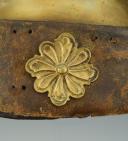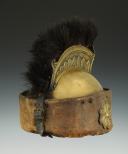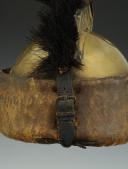
DRAGOON TROOP HELMET, model 1763, Former Monarchy, circa 1763-1770.
Sold out
TROOP HELMET OF DRAGOONS, model 1763, Old Monarchy, circa 1763 - 1770.
Bowl in one-piece brass, round in shape, topped with a crest composed of two fins and a mask: each fin is stamped at the top in relief with a molding and on the rear part a stylized protruding hook, the background is sandblasted and stamped with eight stylized palmettes decreasing towards the back, their base is folded outwards and fixed to the bowl by means of three brass rivets, max H. 5.3 cm. The mask is made of brass stamped with a head of Medusa, mask H 8.9 cm, it is welded to the fins. The crest is reinforced at the top by a steel blade on which the mane is fixed. Mane in black horsehair cut in a brush shape, H at the front 6 cm. Turban in strong leather covered with a calf band, H approximately 8 cm. Stamped brass rosettes, with scalloped edges, decorated with eight molded ribs, diameter 5.9 cm, with a central part in the shape of a drop; they are attached to the turban with a double brass tab. At the back of the turban, in the lower part, a leather strap (width 1 cm) is sewn with a brass buckle (H 1.8 cm x width 1.3 cm) for adjusting the size. At the back of the band in the upper part, a second leather strap is vertically sewn with brass buckles (H 1.1 cm x width 2.2 cm) which attach the mane, at the base of which a counter-strap is sewn. Interior liner composed of a brown leather band sewn to the turban, H 5.5 cm, topped with an ecru liner of about 7 cm. The upper part of the liner has a lace to tighten it to the head size.
France.
Old Monarchy, circa 1763 - 1770.
Good condition, the originally curly mane has been cut into a brush shape; the hairs of the band are missing; the skin has some cracks, pierced by the iron staples intended to attach the turban; the inner band of canvas has a tear and a hole.
NOTE:
The dragoon helmets of the Old Monarchy were introduced in France by Marshal Saxe around 1760. They equipped the dragoons but also some foreign volunteer units; there are a number of variations in both the decorative details and the manufacturing style.
HISTORICAL:
The history of the dragoon helmets of the Old Monarchy was summarized very well by the officials of the Army Museum, Hôtel des Invalides, Paris, in their educational program for youth, the text and the link of which we advise you to visit.
Educational program of the Army Museum - Hôtel des Invalides / jeunes@musee-armee.fr
https://www.musee-armee.fr/fileadmin/user_upload/Documents/Support-Visite-Fiches-Objets/Fiches-Louis-XIV-Napo-Bonaparte/MA_casque-dragon.pdf
Until the mid-17th century, armor remained a widely used protection on the battlefields. From the reign of Louis XIV, these metal defenses were gradually abandoned. They reappear in part in the following century, as evidenced by the crested helmet worn by the dragoons.
The object itself...
This officer's dragoon helmet corresponds to a model in use between 1779 and 1791. The gilded brass bowl (called similor at the time) is made in one piece. At its base, the band is clipped. It consists of a wide band of rigid leather (usually made of cowhide), covered with a turban in panther or leopard skin, or if not available, in dyed seal skin. The band forms a small peak at the front, reminiscent of the old dragon bonnet. The presented helmet has lost its fur. A supple skin, the basane, sewn to the lower edge of the band, is folded inside the helmet to form the liner that adjusts to the soldier's head. The whole set is adjustable with a buckle at the back of the band. The bowl is topped with a crest whose two fins are joined by the mask (the front part of the crest). A black mane, sometimes curly, more often long and stiff as in the model presented, falls to the back of the helmet to protect the soldier's neck. The hairs at the front are tied into a tight tassel with a cord. The entire assembly is sewn with metal thread on a turned leather sole and fixed inside the crest.
The officer's model resembles that of the troops but its metal elements are gilded and its decorations more elaborate. This helmet, of very high execution quality, shows fins stamped with palmettes on a sandblasted background. The mask is decorated in its upper part with the head of Medusa and at the foot of a palm leaf. Stylized flowers adorn the brass rosettes fixed on each side of the leather band. The rosettes hold the cheekpieces, here in black velvet embroidered with gold and cannetille threads simulating small scales. The cheekpieces are closed by a corded strap and a gold passementerie button.
The 1786 regulation added a movable visor to this helmet that can be clipped to the turban. It does not indicate the gilded brass tassel holder visible on this model; the tassel matching the company's color was usually slipped between the band and the turban.
The object tells us...
In 1743, Maurice de Saxe, having entered the service of the King of France, raised a corps composed of volunteers from Eastern Europe. Antiquity was in fashion and the future marshal, also a theater enthusiast, equipped his riders with an ancient-style helmet consisting of a seal skin band topped with a low crest. This prestigious corps became, in 1761, the Schomberg Dragoon Regiment. The helmet and the green uniform were assigned to all dragoons by a royal ordinance in 1763. This uniform distinguished them from the line cavalry. Indeed, although in the 18th century they were increasingly assimilated to the cavalry, the dragoons were originally mounted infantry. The idea of these hybrid formations is very ancient; however, tradition attributes their creation for France to Marshal de Brissac when he held Piedmont at the end of the Italian Wars, between 1550 and 1560. Deprived of cavalry, he formed with elite infantrymen capable of riding a horse, the first "dragon" formation (the etymology of this term is still controversial). He used them for escort missions, reconnaissance (the scouting), vanguard, etc. These mounted infantry bands quickly multiplied, but it was not until the reign of Louis XIV, in 1656, that the first dragoon regiment was raised. There were four of them in 1668, and the following year, a decree organized the new arm. The king recalled their double training as infantrymen and riders, created the general staff and the position of Colonel General of Dragoons, which he gave to the Duke of Lauzun.
The corps grew rapidly, and the royal army had thirteen dragoon regiments in 1680. During Louis XIV's reign, the dragoons wore red uniforms and were capped with a long-pointed felt bonnet. They wore black leather shoes and leggings, while the line cavalry wore high boots. Their individual armament reflected their dual affiliation: it included an infantry rifle, a holster pistol, and a cavalry saber. They were also distinguished by their ceremonial instruments, drum and oboe, and their guidon smaller than an infantry flag, cut in two rounded points.
The dragoons were intended for harassment missions, opening paths, covering troops on the move, and escorting convoys. During sieges, they participated with the infantry in trench service and led the assault column. In pitched battles, they were alongside the cavalry, on the wings, and took part in pursuing the defeated enemy or, on the contrary, protected the army's retreat. Louvois deployed them in the Cévennes (1702-1705) to compel Protestants to convert. Their brutality towards the population gave rise to the term "dragooning".
The decline of siege warfare and the return to maneuver warfare in the 18th century reinforced their place in the cavalry, into which they were incorporated in 1784.
Bowl in one-piece brass, round in shape, topped with a crest composed of two fins and a mask: each fin is stamped at the top in relief with a molding and on the rear part a stylized protruding hook, the background is sandblasted and stamped with eight stylized palmettes decreasing towards the back, their base is folded outwards and fixed to the bowl by means of three brass rivets, max H. 5.3 cm. The mask is made of brass stamped with a head of Medusa, mask H 8.9 cm, it is welded to the fins. The crest is reinforced at the top by a steel blade on which the mane is fixed. Mane in black horsehair cut in a brush shape, H at the front 6 cm. Turban in strong leather covered with a calf band, H approximately 8 cm. Stamped brass rosettes, with scalloped edges, decorated with eight molded ribs, diameter 5.9 cm, with a central part in the shape of a drop; they are attached to the turban with a double brass tab. At the back of the turban, in the lower part, a leather strap (width 1 cm) is sewn with a brass buckle (H 1.8 cm x width 1.3 cm) for adjusting the size. At the back of the band in the upper part, a second leather strap is vertically sewn with brass buckles (H 1.1 cm x width 2.2 cm) which attach the mane, at the base of which a counter-strap is sewn. Interior liner composed of a brown leather band sewn to the turban, H 5.5 cm, topped with an ecru liner of about 7 cm. The upper part of the liner has a lace to tighten it to the head size.
France.
Old Monarchy, circa 1763 - 1770.
Good condition, the originally curly mane has been cut into a brush shape; the hairs of the band are missing; the skin has some cracks, pierced by the iron staples intended to attach the turban; the inner band of canvas has a tear and a hole.
NOTE:
The dragoon helmets of the Old Monarchy were introduced in France by Marshal Saxe around 1760. They equipped the dragoons but also some foreign volunteer units; there are a number of variations in both the decorative details and the manufacturing style.
HISTORICAL:
The history of the dragoon helmets of the Old Monarchy was summarized very well by the officials of the Army Museum, Hôtel des Invalides, Paris, in their educational program for youth, the text and the link of which we advise you to visit.
Educational program of the Army Museum - Hôtel des Invalides / jeunes@musee-armee.fr
https://www.musee-armee.fr/fileadmin/user_upload/Documents/Support-Visite-Fiches-Objets/Fiches-Louis-XIV-Napo-Bonaparte/MA_casque-dragon.pdf
Until the mid-17th century, armor remained a widely used protection on the battlefields. From the reign of Louis XIV, these metal defenses were gradually abandoned. They reappear in part in the following century, as evidenced by the crested helmet worn by the dragoons.
The object itself...
This officer's dragoon helmet corresponds to a model in use between 1779 and 1791. The gilded brass bowl (called similor at the time) is made in one piece. At its base, the band is clipped. It consists of a wide band of rigid leather (usually made of cowhide), covered with a turban in panther or leopard skin, or if not available, in dyed seal skin. The band forms a small peak at the front, reminiscent of the old dragon bonnet. The presented helmet has lost its fur. A supple skin, the basane, sewn to the lower edge of the band, is folded inside the helmet to form the liner that adjusts to the soldier's head. The whole set is adjustable with a buckle at the back of the band. The bowl is topped with a crest whose two fins are joined by the mask (the front part of the crest). A black mane, sometimes curly, more often long and stiff as in the model presented, falls to the back of the helmet to protect the soldier's neck. The hairs at the front are tied into a tight tassel with a cord. The entire assembly is sewn with metal thread on a turned leather sole and fixed inside the crest.
The officer's model resembles that of the troops but its metal elements are gilded and its decorations more elaborate. This helmet, of very high execution quality, shows fins stamped with palmettes on a sandblasted background. The mask is decorated in its upper part with the head of Medusa and at the foot of a palm leaf. Stylized flowers adorn the brass rosettes fixed on each side of the leather band. The rosettes hold the cheekpieces, here in black velvet embroidered with gold and cannetille threads simulating small scales. The cheekpieces are closed by a corded strap and a gold passementerie button.
The 1786 regulation added a movable visor to this helmet that can be clipped to the turban. It does not indicate the gilded brass tassel holder visible on this model; the tassel matching the company's color was usually slipped between the band and the turban.
The object tells us...
In 1743, Maurice de Saxe, having entered the service of the King of France, raised a corps composed of volunteers from Eastern Europe. Antiquity was in fashion and the future marshal, also a theater enthusiast, equipped his riders with an ancient-style helmet consisting of a seal skin band topped with a low crest. This prestigious corps became, in 1761, the Schomberg Dragoon Regiment. The helmet and the green uniform were assigned to all dragoons by a royal ordinance in 1763. This uniform distinguished them from the line cavalry. Indeed, although in the 18th century they were increasingly assimilated to the cavalry, the dragoons were originally mounted infantry. The idea of these hybrid formations is very ancient; however, tradition attributes their creation for France to Marshal de Brissac when he held Piedmont at the end of the Italian Wars, between 1550 and 1560. Deprived of cavalry, he formed with elite infantrymen capable of riding a horse, the first "dragon" formation (the etymology of this term is still controversial). He used them for escort missions, reconnaissance (the scouting), vanguard, etc. These mounted infantry bands quickly multiplied, but it was not until the reign of Louis XIV, in 1656, that the first dragoon regiment was raised. There were four of them in 1668, and the following year, a decree organized the new arm. The king recalled their double training as infantrymen and riders, created the general staff and the position of Colonel General of Dragoons, which he gave to the Duke of Lauzun.
The corps grew rapidly, and the royal army had thirteen dragoon regiments in 1680. During Louis XIV's reign, the dragoons wore red uniforms and were capped with a long-pointed felt bonnet. They wore black leather shoes and leggings, while the line cavalry wore high boots. Their individual armament reflected their dual affiliation: it included an infantry rifle, a holster pistol, and a cavalry saber. They were also distinguished by their ceremonial instruments, drum and oboe, and their guidon smaller than an infantry flag, cut in two rounded points.
The dragoons were intended for harassment missions, opening paths, covering troops on the move, and escorting convoys. During sieges, they participated with the infantry in trench service and led the assault column. In pitched battles, they were alongside the cavalry, on the wings, and took part in pursuing the defeated enemy or, on the contrary, protected the army's retreat. Louvois deployed them in the Cévennes (1702-1705) to compel Protestants to convert. Their brutality towards the population gave rise to the term "dragooning".
The decline of siege warfare and the return to maneuver warfare in the 18th century reinforced their place in the cavalry, into which they were incorporated in 1784.
Reference :
23552 1
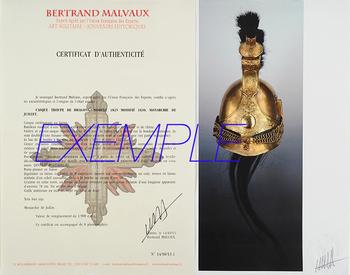
Next update Friday, december 26 at 13:30 PM
FOR ALL PURCHASES, PAYMENT IN MULTIPLE CHECKS POSSIBLE
bertrand.malvaux@wanadoo.fr 06 07 75 74 63
SHIPPING COSTS
Shipping costs are calculated only once per order for one or more items, all shipments are sent via registered mail, as this is the only way to have proof of dispatch and receipt.
For parcels whose value cannot be insured by the Post, shipments are entrusted to DHL or Fedex with real value insured, the service is of high quality but the cost is higher.
RETURN POLICY
Items can be returned within 8 days of receipt. They must be returned by registered mail at the sender's expense, in their original packaging, and in their original condition.
AUTHENTICITY
The selection of items offered on this site allows me to guarantee the authenticity of each piece described here, all items offered are guaranteed to be period and authentic, unless otherwise noted or restricted in the description.
An authenticity certificate of the item including the description published on the site, the period, the sale price, accompanied by one or more color photographs is automatically provided for any item priced over 130 euros. Below this price, each certificate is charged 5 euros.
Only items sold by me are subject to an authenticity certificate, I do not provide any expert reports for items sold by third parties (colleagues or collectors).
FOR ALL PURCHASES, PAYMENT IN MULTIPLE CHECKS POSSIBLE
bertrand.malvaux@wanadoo.fr 06 07 75 74 63
An authenticity certificate of the item including the description published on the site, the period, the sale price, accompanied by one or more color photographs is automatically provided for any item priced over 130 euros. Below this price, each certificate is charged 5 euros.
Only items sold by me are subject to an authenticity certificate, I do not provide any expert reports for items sold by third parties (colleagues or collectors).
